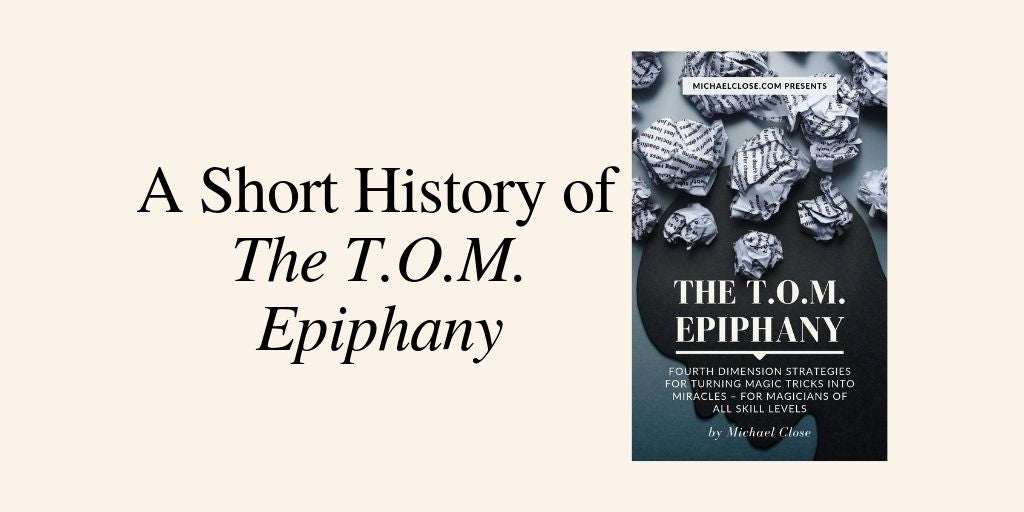
A Short History of The T.O.M. Epiphany
“The creation of something new is not accomplished by the intellect but by the play instinct acting from inner necessity. The creative mind plays with the objects it loves.” – Carl Jung
I have no idea what allows some people to be more creative than others; a fortunate arrangement of neural connections certainly is important. But research has shown everyone is creative, to a greater or lesser degree.
I believe what makes creative breakthroughs happen is the amount of time someone spends ruminating. A musical analogy is this: Someone asked a great blues guitar player how he got so accomplished. He said, “You always have a guitar in your hands.” And that’s how it is with creativity; the creative person is always thinking about something.
Jung describes this process as “play,” which makes it sound like fun and games. Sometimes this is true; much of the time, it isn’t. I have spent many hours in the playpen of my mind trying to pound a square peg into a round hole, without actually understanding the true nature of either the peg or the hole. Then suddenly, without warning, I realize there are other pegs available that fit that hole, or that another hole exists that fits the square peg, or that pounding a peg into a hole is not the solution I was looking for in the first place. Sometimes this is an “Aha!” moment, appearing out of the blue. Most of the time, however, it happens because I have filled my head with other unrelated “stuff” and I finally discover the connection between things I thought were unrelated.
Such is the case with The T.O.M. Epiphany. “T.O.M.” is an acronym for an insurmountable limitation of the magic creative process. (Thoroughly explaining T.O.M. is beyond the scope of this blog; all is explained in the ebook.) I first encountered a version of T.O.M. more than forty years ago, in the work of Stewart James. It took many years for me to internalize Stewart’s process, even at a basic level. I was then faced with a frustrating situation. When I realized how stringently T.O.M. confines our attempts to create new methods for magic effects, two questions immediately came to mind: Why do these constraints exist? Is there any way to circumvent them?
I was at the “square peg/round hole” stage of my thinking; I needed more “stuff” rolling around in my brain. That “stuff” eventually arrived from two disparate sources: 1) the research, organization, and writing required for two of my Targeted Training sessions; 2) my layman-level interest in physics. Almost instantly (and I laugh when I use that word, since “instantly” took forty years), I understood why T.O.M. exists and why we cannot directly escape its limitations. But I also realized there are methods to do an end-run around T.O.M.; these methods will allow us to create magic effects that cannot be unraveled.
T.O.M.’s restrictions arise because we live in three-dimensional space; the key to circumventing it is the utilization of the other dimension available to us: time. In The T.O.M. Epiphany you will learn strategies for accomplishing this. This is not a theoretical or aesthetical discussion. This is nuts-and-bolts information I have applied to simple and more advanced effects. You will immediately be able to appreciate the effectiveness of this approach.
In addition to all the background information you need to understand my approach to this problem, you’ll also learn updated and refined handlings for six tricks, plus a new, previously unpublished two-trick card routine you will want to immediately add to your repertoire.
The real value of The T.O.M. Epiphany is that it will change the way you think about the routines you already perform. The great news is that these changes will not require greater physical dexterity; this means the information is of benefit to magicians of all skill levels.
I am excited about The T.O.M. Epiphany. It took a long time for my thoughts to coalesce, and it was not easy to write. But I think the effort is more than worth it. I sent an early, incomplete draft of the manuscript to several people; here are two comments:
“Wow – wildly thought-provoking.” – Teller
“This is a unique and uniquely useful book. It uncovers a world of techniques on a subject of eternal interest to magicians, one I’ve never seen discussed, except where these ideas first appeared in your own writing. It is ground breaking.” – Pete McCabe
Get your copy today!

Leave a comment